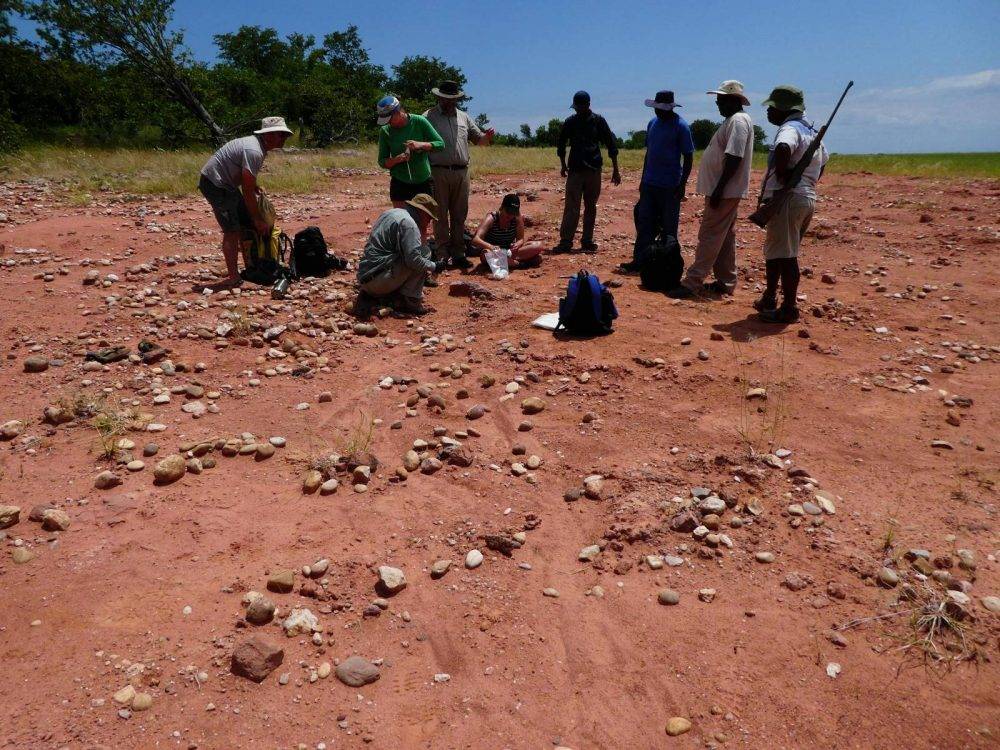Musankwa sanyatiensis leg bones as they were discovered in the ground on Spurwing Island, Lake Kariba, Zimbabwe. (Paul Barrett)
A new species of dinosaur has been unearthed in Zimbabwe, capturing the imagination of scientists and enthusiasts worldwide.
Named Musankwa sanyatiensis, the discovery marks only the fourth dinosaur species to be identified in the country and offers a fascinating glimpse into the prehistoric past of the African continent.
The species was found by a group of scientists who posted their findings in the journal Acta Palaeontologica Polonica.
The global team consists of scientists from the University of the Witwatersrand, the Natural History Museum of Zimbabwe and Stony Brook University in New York and was led by professor Paul Barrett from the Natural History Museum in London.
The researchers believe the dinosaur was bipedal — walked on two legs — and had a long neck. It was part of a group called Sauropodomorpha, characterised by their lizard-like features, long necks and herbivorous feeding habits.
 Musankwa sanyatiensis fossil bones in situ, after mechanical preparation, and after CT scanning. Artist reconstruction of Musankwa sanyatiensis showing position of fossil bones.
(Barrett et al. 2024, Atashni Moopen)
Musankwa sanyatiensis fossil bones in situ, after mechanical preparation, and after CT scanning. Artist reconstruction of Musankwa sanyatiensis showing position of fossil bones.
(Barrett et al. 2024, Atashni Moopen)
These dinosaurs were common during the late Triassic era. This era, around 252 to 201 million years ago, began after Earth’s worst-ever extinction event devastated life and was one of the most significant in the history of our planet. The reason for the extinction is still unknown.
The finding is significant because Musankwa sanyatiensis is the first find in the Mid-Zambezi Basin of northern Zimbabwe in over 50 years. It follows the “Syntarsus” rhodesiensis, the Vulcanodon karibaensis and the Mbiresaurus raathi — Africa’s oldest dinosaur — which was discovered in 2022.
Another aspect that makes the find interesting is that it appears to be related to other species found in South Africa and Argentina. The species was estimated to weigh around 400kg and was noted as one of the largest of its era.
The researchers think the specimen dates back 210 million years which they determined through the remains of a single leg, including its thigh, shin and ankle bones.
“Despite the limited fossil material, these bones possess unique features that distinguish them from those of other dinosaurs living at the same time,” said Dr Kimberley Chapelle, assistant professor at Stony Brook University and an honorary associate at the Evolutionary Studies Institute of the University of the Witwatersrand.
Africa has a rich history of dinosaur finds but, traditionally, the fossils are found in the northern hemisphere. This leads to unequal representation globally of African dinosaurs. Barrett puts it down to undersampling: “Put simply, there have been fewer people looking for and unearthing dinosaurs in comparison with other regions of the world,” he said.
There are fewer dinosaur discoveries on the continent but the finds have been crucial in piecing together the various eras of biodiversity millions of years ago, he said.
There is hope that the find sparks more “findings of ancient life, from dinosaurs to prehistoric plants, mammals, fish, insects, fungi and even microbes”, as the American Museum of Natural History explains.
 The international team composed of scientists from Zimbabwe, South Africa and the UK at the Musankwa sanyatiensis fossil locality on Spurwing Island, Lake Kariba, Zimbabwe.
(Lara Sciscio)
The international team composed of scientists from Zimbabwe, South Africa and the UK at the Musankwa sanyatiensis fossil locality on Spurwing Island, Lake Kariba, Zimbabwe.
(Lara Sciscio)
“Over the last six years, many new fossil sites have been recorded in Zimbabwe, yielding a diverse array of prehistoric animals, including the first sub-Saharan mainland African phytosaurs (ancient crocodile-like reptiles), metoposaurid amphibians (giant armoured amphibians), lungfish and other reptile remains”, Barrett said.
“Based on where it sits on the dinosaur family tree, Musanwka sanyantiensis is the first dinosaur of its kind from Zimbabwe,” Chapelle said. “It, therefore, highlights the potential of the region for further palaeontological discoveries.”
The dinosaur was named after the houseboat the research team used. In the Tongan dialect “musankwa” means “boy close to marriage”.